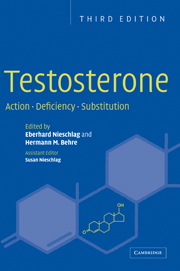Book contents
- Frontmatter
- Contents
- List of contributors
- Preface
- 1 Testosterone: an overview of biosynthesis, transport, metabolism and non-genomic actions
- 2 The androgen receptor: molecular biology
- 3 Androgen receptor: pathophysiology
- 4 Behavioural correlates of testosterone
- 5 The role of testosterone in spermatogenesis
- 6 Androgens and hair: a biological paradox
- 7 Androgens and bone metabolism
- 8 Testosterone effects on the skeletal muscle
- 9 Androgens and erythropoiesis
- 10 Testosterone and cardiovascular diseases
- 11 Testosterone and erection
- 12 Testosterone and the prostate
- 13 Clinical uses of testosterone in hypogonadism and other conditions
- 14 Pharmacology of testosterone preparations
- 15 Androgen therapy in non-gonadal disease
- 16 Androgens in male senescence
- 17 The pathobiology of androgens in women
- 18 Clinical use of 5α-reductase inhibitors
- 19 Dehydroepiandrosterone (DHEA) and androstenedione
- 20 Selective androgen receptor modulators (SARMs)
- 21 Methodology for measuring testosterone, DHT and SHBG in a clinical setting
- 22 Synthesis and pharmacological profiling of new orally active steroidal androgens
- 23 Hormonal male contraception: the essential role of testosterone
- 24 Abuse of androgens and detection of illegal use
- Subject Index
23 - Hormonal male contraception: the essential role of testosterone
Published online by Cambridge University Press: 18 January 2010
- Frontmatter
- Contents
- List of contributors
- Preface
- 1 Testosterone: an overview of biosynthesis, transport, metabolism and non-genomic actions
- 2 The androgen receptor: molecular biology
- 3 Androgen receptor: pathophysiology
- 4 Behavioural correlates of testosterone
- 5 The role of testosterone in spermatogenesis
- 6 Androgens and hair: a biological paradox
- 7 Androgens and bone metabolism
- 8 Testosterone effects on the skeletal muscle
- 9 Androgens and erythropoiesis
- 10 Testosterone and cardiovascular diseases
- 11 Testosterone and erection
- 12 Testosterone and the prostate
- 13 Clinical uses of testosterone in hypogonadism and other conditions
- 14 Pharmacology of testosterone preparations
- 15 Androgen therapy in non-gonadal disease
- 16 Androgens in male senescence
- 17 The pathobiology of androgens in women
- 18 Clinical use of 5α-reductase inhibitors
- 19 Dehydroepiandrosterone (DHEA) and androstenedione
- 20 Selective androgen receptor modulators (SARMs)
- 21 Methodology for measuring testosterone, DHT and SHBG in a clinical setting
- 22 Synthesis and pharmacological profiling of new orally active steroidal androgens
- 23 Hormonal male contraception: the essential role of testosterone
- 24 Abuse of androgens and detection of illegal use
- Subject Index
Summary
General prospects
Why male contraception at all?
The invention of the “pill” for women was undoubtedly one of the most significant medical and cultural events of the twentieth century. Nature has sweetened procreation with the pleasures of sex to guarantee human reproduction. The pill was the culmination of a millennial-long development of methods to disentangle procreation from sex, and has had a substantial impact on society – e.g. on family planning, morality and demography, not to mention economic and political impact. An equivalent pharmacological male method is not yet available.
Female contraception is very effective. Nevertheless, 50% of the 1,000,000 conceptions occurring every day worldwide remain unplanned, of which 150,000 are terminated by abortion, an intervention that will end fatally for 500 of these women. Although improved distribution and utilization of female contraceptive methods might ameliorate this situation, the contribution of a male contraceptive is well worth considering. Men enjoy the pleasures of sex, but can do little to contribute to the tasks of family planning – a pharmacological male contraceptive is perhaps long overdue. In addition, the risks of contraception would also be more fairly shared between women and men. Representative surveys have shown that a pharmacological male contraceptive would be acceptable to large segments of the population in industrial nations, and would thus contribute to further stabilization of population dynamics. It might also help developing countries whose exponential population growth endangers economic, social, and medical progress. Last but not least, male contraception can be considered an outstanding issue in the political field of gender equality.
- Type
- Chapter
- Information
- TestosteroneAction, Deficiency, Substitution, pp. 685 - 714Publisher: Cambridge University PressPrint publication year: 2004
- 12
- Cited by

